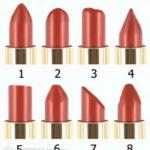Burning temperature of natural silk. How to distinguish natural fabric from synthetic? Cotton, linen, viscose, copper-ammonia
How to distinguish natural fabric from synthetics? This problem especially often arises when purchasing bed linen. People out of habit believe that if it is calico, it must be pure cotton. But, whether it is calico or poplin, this definition does not refer to the quality of the thread from which the fabric is woven, it is the name of the weaving technology. And, as you understand, you can weave it from any thread, even from wire.
Therefore, in order not to feel deceived, you need to know how to check what fiber a product is made of.
The first test is tactile sensation. Even if the fabric is natural, you don't have to like it. And this factor plays an important role when choosing. For example, for many, pure flax fiber seems coarse; they also often talk about thick and high-quality calico.
Satin seems thin to many, although it is completely opaque, like calico, comfortable, and a pleasure to sleep on. Therefore, relying only on tactile sensations, you can just buy soft, pleasant, velvety, but synthetic underwear.
There is a simple home way to check the naturalness of the thread - you need to set it on fire.
If you buy clothes, then, as a rule, there is a spare piece of fabric, you can conduct an experiment on it.
WITH bed linen more complicated, it does not come with a fabric sample, so you will have to be smart about how to check whether the fabric is actually natural, as stated by the manufacturer.
So, if you have a piece of fabric or at least a thread, let's start doing research. To do this, we need a safe place, matches, and the ability to ventilate the room.
How to distinguish natural fabric from synthetic
- Cotton fiber burns with a light flame, burns very quickly and does not leave a strong odor, to some it slightly resembles the smell of burnt paper. There is very little ash left, and it is completely weightless.
- Flax also burns quickly, leaving very little bright gray ash, but leaves no odor.
- Purely wool thread burns very slowly and reluctantly, eventually shrinking into a ball, filling the space unpleasant smell resembling burnt hair or feathers.
- Artificial wool burns very quickly and beautifully - the flame is blue, and the smell will be as if paper was set on fire.
- Viscose obtained artificially from wood, i.e. cellulose is considered a natural fabric. Viscose burns very quickly, but smolders for a long time, actively smoking and emitting the smell of burnt cotton wool. The remaining gray ash crumbles well.
How to distinguish natural silk from artificial silk
Natural silk does not want to burn at all, no matter how hard you try. The thread will shrink into a black knot, and the flame will immediately go out. The smell is vaguely reminiscent of burnt keratinizations (nails, claws, horns), if you have ever heard such a smell.
It is very easy to distinguish artificial silk from natural silk. It burns well and quickly, without crackling or odor.
When buying a silk item, you will not start a fire in the store, so just squeeze the fabric in your hand, unclench your fist after a while and see if the fabric is wrinkled. Artificial silk will have noticeable creases, while natural silk will wrinkle quite a bit.
A characteristic feature of all burnt natural samples is the ability to easily crumble combustion residues. Artificial thread does not provide such an opportunity, in addition, when artificial material burns, it emits an odor mixed with sourness.
Acetate silk can melt in acetone, which cannot be said about natural silk.
IN Lately a lot of mixed fabrics have appeared containing natural thread in combination with artificial. The manufacturer is required to indicate the percentage of all types of threads - these can be acrylic, acetate fiber, lavsan and other artificial additives. If you set fire to such fabric, the flame will be similar to the thread that contains the most of it. The smell will also determine the composition, but the remains of combustion cannot be easily crushed.
Mixed fabrics used in the production of bed linen are, as a rule, very pleasant to the touch, have a durable color, practically do not wrinkle and last a long time if used correctly.
Be able to distinguish natural fabric from artificial It is also necessary to properly care for the product.
Clothing made from linen fabric is especially valued by wearers due to its breathability, wear resistance, smooth surface, hygroscopicity and fairly high strength. The best method To verify the authenticity of the material is a laboratory test. But this method requires considerable time and money. Therefore, when buying clothes or household items, it is better to resort to offline methods.


Methods for identifying linen fabric
Visual. Linen material has a shiny appearance, while cotton fabrics have a matte surface.
Tactile. Linen fabrics are quite stiff and cause a slight chill when in contact with the body.
To break. To conduct the study, it is necessary to remove the thread and break it. The linen thread will have a pointed appearance. In the case of cotton, a fluffy tassel of short and even fibers remains at the end of the thread.
Crumpling. Take the thread in your hand and close it into a fist for a few seconds. Linen thread produces more folds compared to cotton thread.
Combustion. Light the fabric and wait a few seconds. Linen-based material emits virtually no odor, while cotton smokes and has a strong odor.
Color. Natural linen fabrics without dyes are available in three variations - ivory, light brown bark and shades of gray.
Find out more information about the properties of flax, as well as others natural materials, you can contact the company’s specialists “ Vulcana».
Although we ourselves sometimes do not mind being deceived. In pursuit of a low price, instead of quality materials, we often give preference to cheaper fabrics. At best, such savings result in discomfort when wearing, at worst - allergies and other health problems.
What fabrics should you buy from when building your wardrobe? How to avoid falling for the bait of unscrupulous sellers? Is it possible to determine the composition of a thing without laboratory tests? We talked about this and much more with a candidate of technical sciences specializing in “Technology of textile materials, clothing and knitwear» Galina Skripko on AiF.ru.
It's not cold in winter, it's not hot in summer
Natalya Kozhina, AiF.ru: Galina Alekseevna, what is “healthy clothing”, which in fact should make up our wardrobe?
Galina Skripko: Clothing is considered healthy if the textile material is made from natural raw materials (cotton, wool, flax, natural silk, etc.) or from material with a high content of it.
It is always comfortable to wear such clothes: it is not cold in winter, and not hot in summer, because the material containing natural fibers has unique property- keep warm for a long time, slowly cooling, and vice versa, keep cool, slowly warming up. Such material does not have a negative effect on the human biofield, since natural fibers are not capable of accumulating static tension. Due to the high breathability and ability of the material to absorb moisture, the clothing becomes hygienic.
N.K. “AiF.ru”: Is it possible to determine good and high-quality fabric only by its price?
G.S.: No. The initial price for the product is determined by the manufacturer, the final price is determined by the distributor. Both focus on consumer demand when determining prices. In this case, less fashion clothes, although of high quality, can be offered to the buyer at a lower price than a branded one made from lower quality raw materials.
Sometimes, in order to increase sales, manufacturers and distributors of textile products directly deceive the buyer by indicating deliberately false information about the fiber composition of the material on the product label or price tag.
N.K. “AiF.ru”: If price is not an indicator, then what factors can help determine the quality of the fabric?
G.S.: Subjectively, the quality of the material can be determined by appearance and to the touch. Some natural fibers have a characteristic odor. For example, wool has its own smell, it is difficult to describe it, but when we smell it, we remember it. Why does wool smell? Because she has fatliquoring agents, these products have such a specific smell. Cotton smells fresh.
The naturalness of modified fabrics can be determined by external signs difficult even for a professional. Thus, fabric or knitwear made from mercerized cotton (Mercerized cotton is cotton that undergoes alkali treatment. The fiber becomes thinner, shrinks less and is more even) in appearance differs little from material made from polyester cotton-like fiber.
In everyday conditions, to determine the type of clothing fibers, we can recommend a method based on the characteristics of combustion and the characteristic odor of the combustion residues of the fibers. For example, cotton yarn burns quickly, leaving a burnt paper smell; the burnt residue is easily crushed between your fingers. Yarn made from polyester fibers is characterized by rapid attenuation, the burnt residue has the appearance of a solid black ball, and there is no smell. The presence of fur or natural silk in yarn is determined by the characteristic smell - burnt horn. If the combustion residue does not crumble when rubbed between your fingers, then the yarn contains synthetics.
N.K. “AiF.ru”: Often in a store you can see things made of 100 percent cotton (i.e., identical in composition), but at the same time they will feel completely different to the touch, why? In this case, what fabric should you choose?
G.S.: Everything is correct. Textile materials with the same fiber composition can have different textures. Texture is determined by the density of the fabric and its thickness. The density of the fabric depends on the density and type of weave of the yarn, and the thickness depends on the thickness of the yarn. If speak about cotton fabrics, then their range is very wide: calico, chintz, satin, crepe, cashmere, flannel, flannel, cambric, etc. The thinnest and most expensive fabric is cambric. It is made from fine, tightly spun cotton yarn, which is obtained from high-quality long-staple cotton. When assessing the quality of the fabric or material of the product, you should carefully examine its surface for defects: thickening of the yarn in limited areas, fluffiness (the presence of small lumps of tangled fibers on the surface of the fabric), knots, violations in limited areas of the density of the fabric due to vacuum or compaction between the interweaving of threads , the presence of distortions in the direction of the threads, uneven coloring, displacement of the pattern, etc.
Fabric and knitwear, the yarn of which is made from high-grade fiber, has a smooth surface. The denser the material, the less it deforms during product operation. However, dense material does not mean thick.
W, CO, CVI - designations that are important to know
N.K. "AiF.ru": What fabric should be used when creating a children's wardrobe?
G.S.: The production of children's clothing requires its compliance with sanitary and hygienic rules and regulations (SanPin), according to which children's underwear up to size 32 and hosiery up to size 16 should not contain synthetic fibers. It is allowed to replace part of the cotton with artificial fiber - viscose:
- up to 10%, for toddler underwear (up to size 28) and hosiery up to size 16;
- up to 30%, for children's underwear up to size 32.
N.K. “AiF.ru”: What fabric composition is ideal for underwear and swimwear?
G.S.: Underwear made from 100% cotton jersey is considered ideal. To increase the elasticity of knitwear, it is permissible to add elastic thread (elastane, spandex) to the yarn, the content of which should not exceed 2-1%. Underwear made from such knitwear is not only hygienic, but also more comfortable, as it fits tightly to the body.
N.K. “AiF.ru”: Galina Alekseevna, please tell us about the symbols that are often used on labels, what do they mean?
G.S.: The designation of raw materials must contain the full name of the types of fibers or their abbreviated designation. The abbreviated designation is mainly used by foreign manufacturers. For example, cotton (cotton) - CO, ALG; flax (flax) - Li; wool (wool) - W or WP, WL, WA (alpaca, llama, angora wool): silk (silk) - SE. For artificial chemical fibers the following designations are used: viscose (viskose) - Vis, VI; high-modulus fiber (Siblon, Modal) - CVI, MD; acetate - AC. Synthetic fibers designate: polyester (polyester) - PE, PE, PES, PL; polyacrylonitrile (acrylic) - PAN, PAC, RS; polyamide (polyamide) - PA, RA; polyurethane (polyurethane, elastane) - PU, PU, EA.
In duplicated canvases, the composition of the raw material is indicated separately for each layer.
When secondary raw materials are included in the material, the words “recycled raw materials” and its type must be indicated.
The easiest way to determine what fiber a purchased fabric is made from is to use a combustion test. Natural fibers burn and char, turning into ash. Synthetic ones melt, leaving a hard lump. Cotton and linen fabrics (from plant fibers), as well as wool and silk (from animal fibers) burn equally.
Acetate and acrylic fabrics
They burn and melt in the flame and outside it, when they have already been removed from the flame. After burning, a solid lump remains. Acetate fabric can be easily identified by placing a piece of it in nail polish remover: the acetate will dissolve in it.
Polyester, nylon and other synthetic materials
They do not burn, but only melt in the flame or a short time after removing it with a chemical smell, leaving a hard lump.
Wool and silk
They burn slowly, charring and curling into rings. Sometimes they only burn while in the flame. They smell strongly and not very pleasantly, like burnt hair or feathers, and leave brittle ash.
Cotton and linen
They burn quickly followed by a glow. When burned, they smell like burnt paper, forming soft gray ash.
The comfort of a product in sewing and wearing largely depends on fibrous composition threads from which the fabric is made. Unfortunately, the fiber composition of fabrics is not always indicated correctly or is not indicated at all. Therefore, it is important to learn how to determine the fibrous composition yourself.
The fibrous composition can and should be determined by appearance, touch and the nature of combustion. A combustion test is the simplest and most accurate way to determine the fibrous composition of a material. All you need for this is a piece of material, tweezers, a lighter and a saucer.
When conducting a combustion test, we pay attention to the nature of the flame, smell, density and color of the ash.
Next, watch the video or read the text below
More natural plant fibers
Cotton, flax, nettle, hemp... are based on the natural polymer cellulose.
Combustion character:
Burn with an intense yellow flame. After fading, there is a light smoke with the smell of burnt paper. After combustion, a light, fragile gray-white ash remains, which can be easily rubbed with your fingers.
Natural animal fibers
Natural silk is based on a natural polymer, the protein fibroin.
Wool is based on a natural polymer, the protein keratin.
Combustion character:
When brought into the flame they light up, when taken out of the flame they die out. The smell of burnt hair (feather, bone). After combustion, dark, brittle ash remains and can be easily rubbed with your fingers.
Wool has a richer smell of burnt hair than natural silk.
Man-made fibers
Viscose, bamboo - based on natural polymer cellulose
The combustion pattern is similar to cotton:
Burn with an intense yellow flame. After combustion, a fragile ash of gray or dark color remains, which is easily rubbed with your fingers.
Synthetic fibers
When introduced into the flame, nylon melts and ignites with difficulty. If the molten mass begins to drip, combustion stops and a melted ball forms at the end.
Lavsan and nitron burn with a yellow, smoky flame, forming a hard melted ball that does not crumble or grind with great difficulty. A hard melted edge is formed on the edge of the material
Unpleasant smell - burnt plastic
In the video you saw how the most common synthetic materials burn. Perhaps the pieces of fabric that you examine will have a slightly different combustion pattern. This is normal, because fibers are often mixed in different combinations, fabrics undergo a wide variety of finishes, and this all undoubtedly affects the combustion behavior.
By and large, your task is to learn to distinguish between natural materials and synthetic ones. And distinguishing synthetic ones from each other is not so important.
The key to the success of a future product is right choice fabrics.
If you choose a fabric solely based on the criterion “like it or not” and “the color is cheerful”, then it is difficult to count on good result. The color may be cheerful, but how will it be sewn?
To learn how to easily choose fabrics that are easy to sew and comfortable to wear, come to the master class






